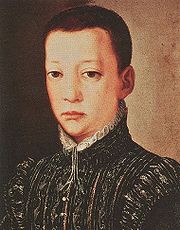
Don Pietro de' Medici
Encyclopedia

Cosimo I de' Medici, Grand Duke of Tuscany
Cosimo I de' Medici was Duke of Florence from 1537 to 1574, reigning as the first Grand Duke of Tuscany from 1569.-Biography:...
and Eleonora di Toledo
Eleonora di Toledo
Eleanor of Toledo Eleanor of Toledo Eleanor of Toledo (Italian: Eleonora di Toledo (1522 – 17 December 1562), born Doña Leonor Álvarez de Toledo y Osorio, was a Spanish noblewoman who was Duchess of Florence from 1539. She is credited with being the first modern first lady, or consort...
.
Early in 1571 he went to Rome and in the spring of 1575 he went to Venice. In 1571 he married his first cousin Eleonora di Garzia di Toledo
Eleonora di Garzia di Toledo
Eleonora di Garzia di Toledo , more often known as "Leonora" or "Dianora", was the daughter of García Álvarez de Toledo, 4th Marquis of Villafranca, Duke of Fernandina, and the wife of Don Pietro de' Medici, a son of Cosimo I de' Medici, Grand Duke of Tuscany...
, whom he accused of adultery and strangled with a dog leash in July 1576 at the Villa Medici at Cafaggiolo
Villa Medici at Cafaggiolo
The Villa Medicea di Cafaggiolo is a villa situated near the Tuscan town of Barberino di Mugello in the valley of the River Sieve, some 25 kilometres north of Florence, central Italy. It was one of the oldest and most favoured of the Medici family estates, having been in the possession of...
. He also had her supposed lover Bernardino Antinori imprisoned and killed.

His correspondence proves that he had serious money problems. He came to Italy in July 1584 to ask his brothers to cover his debts, incurring their disapproval for living with a woman with a questionable reputation. The Medici court tried to arrange a marriage for Pietro. In July 1586 he went back to Spain, where he continued to accumulate debts. He came back to Italy in November 1587 after Francesco I de' Medici's death and stayed until September 1589, when he went back to Spain.
His marriage to Dona Beatriz de Lara, daughter of Manuel de Menezes
Manuel de Menezes, Duke of Vila Real
D. Manuel of Menezes was the second son of Pedro de Menezes 5th Marquis of Vila Real and of his wife, Beatrice of Lara ....
, the Portuguese
Portugal
Portugal , officially the Portuguese Republic is a country situated in southwestern Europe on the Iberian Peninsula. Portugal is the westernmost country of Europe, and is bordered by the Atlantic Ocean to the West and South and by Spain to the North and East. The Atlantic archipelagos of the...
Duke of Vila Real
Duke of Vila Real
Duke of Vila Real was a Portuguese title of nobility created by royal decree, dated from February 28, 1585, by King Philip I of Portugal , and granted to Dom Manuel de Menezes, 5th Marquis of Vila Real and 7th Count of Vila Real.The title was granted by the King in one life, to the 5th Marquis of...
, in 1593 did little to stabilize him economically and emotionally. Pietro continued to see his lover Antonia de Carvajal who gave him five children out of wedlock. He also had an illegitimate son with Maria della Ribera.
He kept writing to his brother Ferdinando I de' Medici, asking for a portion of the family fortune to cover his debts. In 1596 he came to Italy to appeal in vain to the Pope to side with him in the controversy. Pietro died, deeply in debt, before turning 50. After his death his illegitimate children were all brought to Florence to be cared for by the Medici. Pietro was buried in the Monasterio de la Santissima Trinidad in Madrid. His corpse was later brought to Florence by Cosimo II de' Medici.

